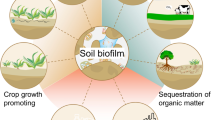Abstract
High-throughput sequencing technology was used to reveal the composition and distribution of fungal community structure in the Yellow River Delta under bare land and four kinds of halophyte vegetation (saline seepweed, Angiospermae, Imperata and Apocynum venetum [A. venetum]). The results showed that the soil quality continuously improved with the succession of salt vegetation types. The soil fungi richness of mild-salt communities (Imperata and A. venetum) was relatively higher, with Shannon index values of 5.21 and 5.84, respectively. The soil fungi richness of severe-salt-tolerant communities (saline seepweed, Angiospermae) was relatively lower, with Shannon index values of 4.64 and 4.66, respectively. The UniFrac metric values ranged from 0.48 to 0.67 when the vegetation was in different succession stages. A total of 60,174 valid sequences were obtained for the five vegetation types, and they were classified into Ascomycota, Basidiomycota, Chytridiomycota, Glomeromycota and Mucoromycotina. Ascomycota had the greatest advantage among plant communities of Imperata and A. venetum, as indicated by relative abundances of 2.69 and 69.97 %, respectively. Basidiomycota had the greatest advantage among mild-salt communities of saline seepweed and Angiospermae, with relative abundances of 9.43 and 6.64 %, respectively. Soil physical and chemical properties were correlated with the distribution of the fungi, and Mucor was significantly correlated with soil moisture (r = 0.985; P < 0.01). Soil quality, salt vegetation and soil fungi were influenced by each other.


Similar content being viewed by others
References
An D, Zhao G, Chang C, Wang ZR, Li P, Zhang TR, Jia JC (2016) Hyperspectral field estimation and remote-sensing inversion of salt content in coastal saline soils of the Yellow River Delta. Int J Remote Sens 37:455–470
Babu AG, Reddy MS (2011) Diversity of arbuscular mycorrhizal fungi associated with plants growing in fly ash pond and their potential role in ecological restoration. Curr Microbiol 63:273–280
Chen WF, Shi YX (2010) Characteristics of microbial distribution of soil in different vegetation types in the Yellow River Delta. Acta Agrestia Sin 6:859–864
Dodd JC, Boddington CL, Rodriguez A, Gonzalez-Chavez C, Mansur I (2012) Mycelium of arbuscular mycorrhizal fungi (AMF) from different genera: form function and detection. Plant Soil 226:131–151
Filion M, St-Arnaud M, Fortin JA (1999) Direct interaction between the arbuscular mycorrhizal fungus Glomus intraradices and different rhizosphere microorganisms. New Phytol 141:525–533
Gao YC, Wang JN, Guo SH, Hu YL, Li TT, Mao R, Zeng DH (2015) Effects of salinization and crude oil contamination on soil bacterial community structure in the Yellow River Delta region, China. Appl Soil Ecol 86:165–173
Guan B, Yu JB, Lu ZH, Zhang Y, Wang XH (2011) Effects of Water-Salt Stresses on Seedling Growth and Activities of Antioxidative Enzyme of Suaeda salsa in Coastal Wetlands of the Yellow River Delta. Environ Sci 32:2422–2429
He YH, Zhou GY, Wang SJ, Li H (2014) Fungal diversity in Cunninghamia lanceolata plantation soil. Acta Ecol Sin 10:2725–2736
Kettler TA, Doran JW, Gilbert TL (2001) Simplified method for soil Particle-size determination to accompany soil-quality analyses. Soil Sci Soc Am J 65:849–852
Kevin PS, Robert M (1999) Host variation for interactions with beneficial plant-associated microbes. Annu Rev Phytopathol 37:473–491
Kong Q, Ngo HH, Shu L, Fu R, Jiang C, Miao M (2014) Enhancement of aerobic granulation by zero-valent iron in sequencing batch airlift reactor. J Hazard Mater 279:511–517
Kong Q, Wang ZB, Niu PF, Miao MS (2016) Greenhouse gas emission and microbial community dynamics during simultaneous nitrification and denitrification process. Bioresour Technol 210:94–100
Kong Q, Wang ZB, Shu L, Miao MS (2015) Characterization of the extracellular polymeric substances and microbial of aerobic granulation sludge exposed to cefalexin. Int Biodeter Biodegr 102:375–382
O’Donnell AG, Seasman M, Macrae A, Waite I, Davies JT (2001) Plants and fertilisers as drivers of change in microbial community structure and function in soils. Plant Soil 232:135–145
Schloss P, Westcott S, Ryabin T, Hall J, Hartmann M, Hollister EB, Lesniewski RA, Oakley BB, Parks DH, Robinson CJ, Sahl JW, Stres B, Thallinger GG, Van Horn DJ, Weber CF (2009) Introducing mothur: open-source, platform-independent, community-supported software for describing and comparing microbial communities. Appl Environ Microbi 75:7537–7541
Timonen S, Finlay RD, Olsson S, Söderström B (1996) Dynamics of phosphorus translocation in intact ectomycorrhizal systems: non-destructive monitoring using a β-scanner. Fems Microbiol Ecol 19:171–180
Wang FY, Liu RJ (2001) A Preliminary survey of arbuscular mycorrhizal fungi in saline-alkali soil of the Yellow River Delta. Biodivers Sci 4:389–3924
Wang HY, Guo SY, Huang MR, LumbschHT, Wei JC (2010) Ascomycetes has faster evolutionary rate and higher species diversity than Basidiomycetes (Fungi). In: Annual meeting of Chinese Society of fungi abstract book, Beijing, pp 731–730
Wang ZB, Miao MS, Kong Q, Ni SQ (2016) Evaluation of microbial diversity of activated sludge in a municipal wastewater treatment plant of northern China by high-throughput sequencing technology. Desalin Water Treat. doi:10.1080/19443994.2015.1137232
Wright SF, Upadhyaya A (1998) A survey of soils for aggregate stability and glomalin, a glycoprotein produced by hyphae of arbuscular mycorrhizal fungi. Plant Soil 198:97–107
Yao H, He Z, Wilson MJ, Campbell CD (2000) Microbial biomass and community structure in a sequence of soils with increasing fertility and changing land use. Microb Ecol 40:223–237
Acknowledgments
This work was supported by the Natural Science Foundation of Shandong Province under Grant (No. ZR2012DM013), Promotional research fund for excellent young and middle-aged scientisits of Shandong Province (No. BS2014HZ019) and A Project of Shandong Province Higher Educational Science and Technology Program (No. J15LE07).
Author information
Authors and Affiliations
Corresponding author
Additional information
Yan-yun Wang and Du-fa Guo have contributed equally.
Rights and permissions
About this article
Cite this article
Wang, Yy., Guo, Df. Response of Soil Fungi Community Structure to Salt Vegetation Succession in the Yellow River Delta. Curr Microbiol 73, 595–601 (2016). https://doi.org/10.1007/s00284-016-1099-4
Received:
Accepted:
Published:
Issue Date:
DOI: https://doi.org/10.1007/s00284-016-1099-4




